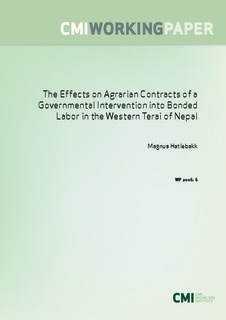| dc.contributor.author | Hatlebakk, Magnus | |
| dc.date.accessioned | 2008-02-19T07:49:35Z | |
| dc.date.accessioned | 2017-03-29T09:12:53Z | |
| dc.date.available | 2008-02-19T07:49:35Z | |
| dc.date.available | 2017-03-29T09:12:53Z | |
| dc.date.issued | 2006 | |
| dc.identifier.isbn | 82-8062-145-8 | |
| dc.identifier.issn | 0804-3639 | |
| dc.identifier.uri | http://hdl.handle.net/11250/2435957 | |
| dc.description.abstract | We study an effective intervention into a specific form of bonded labor.
The intervention led to a shift in agrarian contracts, from bonded labor to sharecropping. By comparing the pre- and post-liberation contracts we evaluate theoretical models of agrarian contracts. We suggest three mechanisms that jointly explain why landlords offered bonded labor contracts pre-liberation.
One mechanism we apply to define bonded labor in contrast to tied labor.
The mechanism, where the outside option as casual labor is endogenously determined by the choice of long-term contract, implies a trade-off for the landlord between efficiency and redistribution of surplus. | |
| dc.language.iso | eng | |
| dc.publisher | Chr. Michelsen Institute | |
| dc.relation.ispartofseries | CMI Working paper | |
| dc.relation.ispartofseries | WP 2006: 6 | |
| dc.subject | Tied labor | |
| dc.subject | Agrarian institutions | |
| dc.subject | Nepal | |
| dc.title | The Effects on Agrarian Contracts of a Governmental Intervention into Bonded Labor in the Western Terai of Nepal | |
| dc.type | Working paper | |
